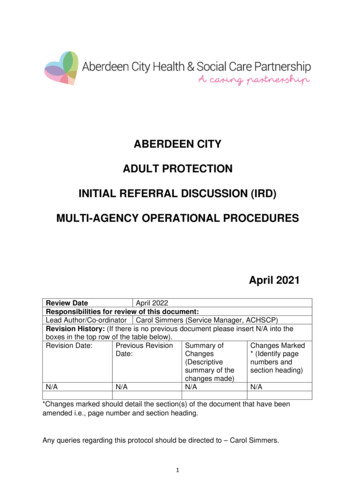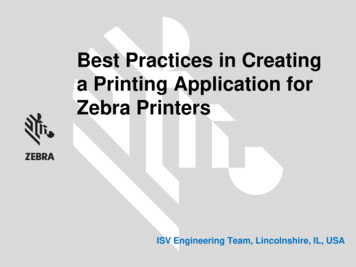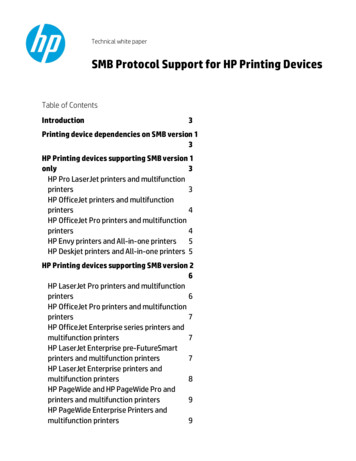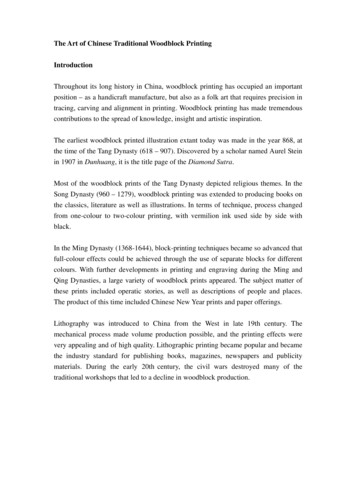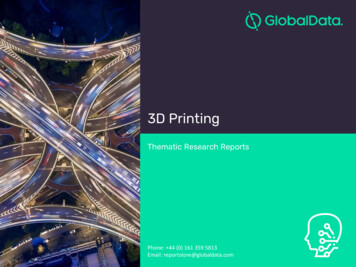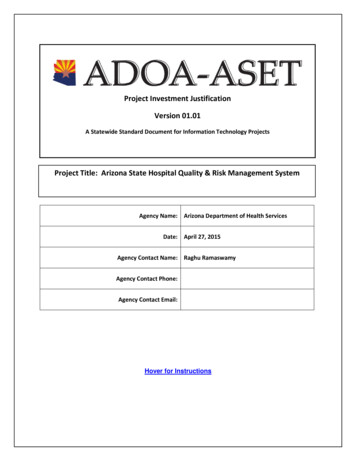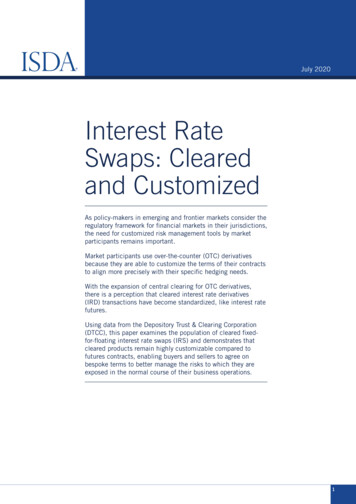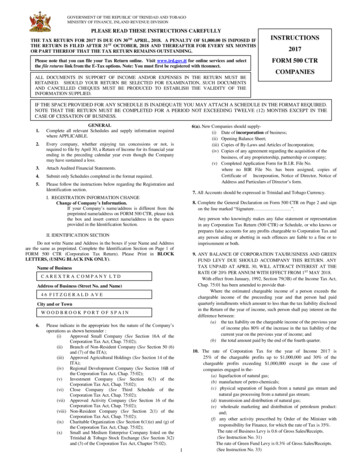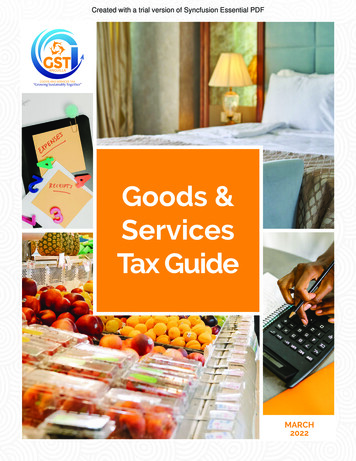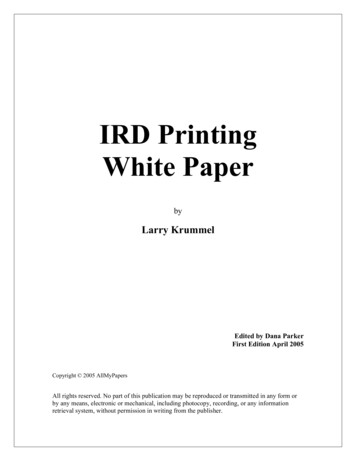
Transcription
IRD PrintingWhite PaperbyLarry KrummelEdited by Dana ParkerFirst Edition April 2005Copyright 2005 AllMyPapersAll rights reserved. No part of this publication may be reproduced or transmitted in any form orby any means, electronic or mechanical, including photocopy, recording, or any informationretrieval system, without permission in writing from the publisher.
IRD Printing White PaperExecutive Summary . 1Objective . 1Target Audience . 1Summary . 1Introduction . 4What is Check 21 . 4What is an IRD . 4What are the standards . 5Requirements of the standards . 6IRD Examples . 7Valid IRDs for Printing . 9Optional Data . 10Region . 11Region 1B . 11Check Image Back. 11Bank of First Deposit (BOFD) Endorsement . 11IRD Printing as it Relates to the Standards . 12Original IRD Versus Subsequent IRD . 14IRD Validity Issues . 15Challenges . 16Printer Issues . 16Calibration . 16Printer Control . 17Print Server and Network Controlled Printers. 17Printing Language and Page Composition--PDF versus IPCL . 19Page Composition Overview . 19Ramifications. 20Fonts, Fusers, Toners and Magnetic Ink Issues . 22Fonts . 22MICR . 23On Us. 24Fusers & Toners . 25Paper Issues . 25Double Printing Issues . 25Operator training Issues . 25Bursting Issues . 26Image Issues . 27Image Files. 27Image Quality . 28Additional Real World Issues. 29Image Quality Examples . 30Additional Real World Issues Example . 36Image Size . 37Bandwidth . 37Image Alignment . 38Security Issues. 39All My Papers Solutions. 41AllMyPapers Check Image Tools . 41Table of Figures . 42Glossary . 43 All My Papers 2005
IRD Printing White Paper 1Executive SummaryObjectiveThis white paper will provide insight into the challenges and issues associated withprinting Image Replacement Documents (IRD).Target AudienceThe primary audience for the paper will be organizations who are planning on developingtheir own custom IRD solution or are having issues with IRD printing solutions such as: Independent Software Vendors (ISVs) System Integrators Value Added ResellersThe secondary audience are any financial institution that is or will be involved withprinting IRDs including: Banks Financial Institutions Bank IntermediariesSummaryThis paper will help to outline what is the Check 21 Act, what is an IRD and what are thestandards associated with them. Included are examples of IRDs from the currentstandards and an overview of which standards are important to be acquainted with inorder to print a valid IRD.This paper will help demystify and summarize what is needed for a printed paper IRD.Also, this paper will help outline what minimum number of x9.37 specification fields areneed to be populated in order to generate a valid printed IRD.The differences between an original IRD and a subsequent IRD will be explained. Inaddition, many printing issues will be outlined since any printer can print IRDs, but notall printers can print a valid IRD. IRD validity is a major issue when it comes toincorporating Check 21 processes within a financial institution. For example, thecalibration of a printer is needed to insure that the printer is set up correctly to print IRDs.Printing configuration will also be explored.To have a deeper understanding of the check printing process it is best to understand thelanguage used to print images and IRDs. The different printing languages will be outlinedand the different issues associated with each including the speed and quality of theresults.Fonts, fusers, toners and magnetic ink can create a myriad of challenges in printing anaccurate IRD and many of these challenges will be outlined. In addition, different paperhas different effects on checks and IRD printing and paper can cause a number ofunforeseen and difficult to troubleshoot problems. All My Papers 2005
IRD Printing White Paper 2 All My Papers 2005
IRD Printing White Paper 3Printing accurate IRDs require that all the printing hardware, software, and paper work inharmony. Operators need to be properly trained to oversee these processes. In addition, itis important that the printing technology is flexible enough to match different burstersorting orders.Since one component of an IRD is an image, the challenges associated with scanning andimaging the checks will be explored including when dealing with image files the imagescan be quite large. According to the standard, DSTU X9.90–2004, Rev. A, there is norequirement as to the check image file format of the IRD as long as the “IRD’s legibilityand usability are maintained.” Image quality challenges will be outlined since imagequality metrics are used to help determine if an IRD is of high enough quality to beaccepted.Additional topics include bandwidth, security, image alignment and image anchoring. All My Papers 2005
IRD Printing White Paper 4IntroductionWhat is Check 21The Check Clearing Act for the 21st Century or “Check 21” is the federal law that allowsfor the creation of a substitute check. The Check 21 Act was enacted on October 28,2003, and became effective on October 28, 2004. The goal of the law was to facilitatecheck truncation by authorizing substitute checks, to foster innovation in the checkcollection system without mandating receipt of checks in electronic form, and to improvethe overall efficiency of the Nation’s payments system, and for other purposes.1The basis of the law is to enable banks to create a substitute check or IRD, ImageReplacement Document, with required check information that can be transferred fromone bank to another the same way a paper check has in the past. There are manyadvantages to be able to truncate or delete the paper check and create a new form of thecheck. A few of those advantages are: Cost savings. It is estimated that banks will save an estimated 2 billion a year intransportation and processing costs Quick check clearing times – Check clearing time could be cut down fromweeks to hours Fast funds collection – Banks will be able to collect funds on checks faster Faster processing of return of unpaid checksWhat is an IRDAn Image Replacement Document (IRD) is defined, as a substitute machine-readableimage copy of a check that may under certain legal arrangements be the practical andlegal equivalent of the original check.2 The DTSU X9.90-2004, Rev. A standard definesthe allowable uses of an IRD which includes a substitute check as defined in the Check21 Act. Therefore, in most respects IRD and substitute check are interchangeable. Tosimplify, we will be referring to IRD as the name for this printed negotiable instrumentthroughout the rest of this document.An IRD is the legal equivalent of the original check if it has the following requirements: 12Must accurately represent all information on the front and back of the originalcheckContain the legend “This is a legal copy of your check. You can use it the sameway you would use the original check.”Must conform to industry standards applicable to the MICR lineMust conform to the industry standard for the physical characteristics of checks(size, paper, etc.)H.R. 1474 – The Check 21 ActDSTU X9.37 - 2003 All My Papers 2005
IRD Printing White Paper 5While the Law validates the creation of paper IRDs, it does not stipulate that banks mustcreate IRDs or that they have to accept electronic checks. It does, require that once anIRD has been created that all parties must accept them as the legal equivalent. Checks intheir electronic form and the transfer between banking institutions are not covered by theACT but rather by agreements between the parties.In addition, according to the Federal Reserve if an illegible IRD is created then the bankthat created it may be liable for losses, up to the full amount of the check/IRD in theevent of a claim.What are the standardsThere is two ANSI standards that directly control the generation of IRDs and thetransmission of check images: ACS X9.100-140-2004 and ACS DSTU X9.37-2003. Thefirst defines the layout and content of the IRD itself and the second the layout and contentof files with check image data. In addition, the FSTC, Financial Services TechnologyConsortium, has published an Image Quality document that will help define imagequality records in the X9.37 files.3When the Check 21 Act refers to conformance to "industry standards" for creating aSubstitute Check, it is referring to ACS X9.100-140-2004 "Specifications for an ImageReplacement Document--IRD". (NOTE: This was originally published as DSTU X9.90.)Although the Check 21 Act does not require image interchange, it is in reality the wholereason for the law. The ACS document for image interchange is ACS DSTU X9.37. Thefinal version will be X9.100-180-2005. The Federal Reserve Board (FRB) has adoptedDSTU X9.37 as its operating document , The FRB has issued companion documents toclarify issues within the DSTU.In addition, there are many standards that support the printing of IRDs. IRD printing issupported by the following standards, but is not limited to this list: DSTU X9.37-2003 – Specifications for Electronic Exchange of Check and ImageData created by the Accredited Standards Committee X9, Inc. DSTU X9.90–2004, Rev. A, Specifications for an Image Replacement Document– IRD ANS X9.27 (2000) – Print and Testing Specification for Magnetic Ink Printing ANS X9.13 (2001) Specifications for Placement and Location of MICR PrintingThere are many issues related to 9.37 files and IRD printing, which will be expanded onin a later y-phase-1/ All My Papers 2005
IRD Printing White Paper 6Requirements of the standardsThe X9.37-2003 standard outlines what data is required to be transferred betweenfinancial institutions. Currently the standard has a wide interpretation of what is requiredfor an IRD, therefore, it is imperative that financial institutions either know the standardand understand all the implications of the standards or work with vendors that do.The purpose of the Check 21 law is that the financial institution printing the IRD does nothave to know anything about the institutions that will process the IRD, nor have any typeof formal agreement between the institutions. In addition, since financial institutions orother entities are not required to accept an electronic document in place of a check, therewill be the need to print out the IRDs for exchange with those entities.The X9.90-2004 standard establishes the construction, layout, data elements, datacontent, and printing specifications for Image Replacement Documents (IRD).44DTSU X9.90-2004, Rev. A All My Papers 2005
IRD Printing White Paper 7IRD ExamplesHere are examples of a Forward Original IRD from the DTSU X9.90-2004, Rev. AStandard. The examples provided contain check designs and security features that are forillustrative purposes only and are not part of this standard. In addition examples of checkimages are shown in grayscale for illustration purposes only. According to the standardcheck images may be captured and displayed in grayscale or black and white, but theFederal Reserve Bank is requiring all IRDs to be in binary, black and white5This is a LEGAL COPY of yourcheck. You can use it the sameway you would use the originalcheck.Your Bank Optional 2DBarcode SecurityFeatureIRD IdentificationMICR line from original check.Image Anchor PointFigure 1: Forward Original IRD of Personal-Sized Check, Front6(Not to scale)56DTSU X9.90-2004, Rev. ADTSU X9.90-2004, Rev. A All My Papers 2005Scaled Original Scanned Full Front Image*011500120*01/04/20028587408979[053000183] 01/03/20021800539446Scaled Original Scanned Full Front Image
IRD Printing White Paper 8Subsequent endorsementsoverlay printed on Original IRD.(Centered in 20028587408979ENDORSE HERE:FOR DEPOSIT ONLYFIRST UNION NATIONALBANKDO NOT SIGN / WRITE / STAMP BELOW THISLINE 031000011 01/02/2002Scaled Original Scanned Full Back ImageScaled Original Scanned Full Back Image Do not endorse or write below thisInitial BOFD Endorsementoverlay printed on Original IRD.(Anchored at Bottom of 1B.)Line and text overlayprinted on Original IRD.Image AnchorFigure 2: Forward Original IRD of Personal-Sized Check, Back7(Not to scale)7DTSU X9.90-2004, Rev. A All My Papers 2005
IRD Printing White Paper 9Valid IRDs for PrintingIn order to print a valid IRD it is important to fully understand many documentspecifications including but not limited to DSTU X9.90–2004, Rev. A, Specifications foran Image Replacement Document – IRD and DSTU X9.37–2003, Specifications forElectronic Exchange of Check and Image Data. There are many details in thesespecifications as it relates to printing a valid IRD. To help demystify and summarize whatis needed within the paper IRD, examples are outlined in the next few pages to includewhat information is needed on the IRD to be a valid printed IRD.*011500120*01/04/20028587408979This is a LEGAL COPY of yourcheck. You can use it the sameway you would use the originalcheck.[053000183] 01/03/20021800539446Region 2FRegion 3FRegion 1FYour Bank Region 4FRegion 8FRegion 5FFigure 3: Forward Original IRD of Personal-Sized Check, Back8(Not to scale)8DTSU X9.90-2004, Rev. A All My Papers 2005
IRD Printing White Paper 10RegionRegion 1F Check image frontIncludes scanned image of original check. The image is registered in thelower right corner of the region with scaling that maintains the aspect ratio.The image must meet generally accepted standards of image quality. For anoriginal IRD or subsequent IRD this area may contain an image overlay forreturn reasons for example, “RETURN REASON – A NSF – NOTSUFFICIENT FUNDS” or “NOTICE IN LIEU OF RETURN”. If the IRDbeing created is an original IRD, this text overlay shall be printed on the lefthalf of Region 1F. If the IRD being created is a subsequent IRD, this textoverlay shall be printed in the right half of Region 1F.Region 2F Check Truncation InstitutionThis area needs to include the routing number, data and sequence number ofthe institution that imaged or scanned the check.Region 3F IRD Printing InstitutionThis area includes the routing number, data and sequence number of theinstitution that printed the IRD.Region 4F LegendThis area must include the legend, “This is a LEGAL COPY of your check. Youcan use it the same way you would use the original check.”This is the area for the legal copy legend. The legal copy legend isrequired for a legally defined IRD.Region 5F Required MICR RegionThis area includes the MICR line as on the original check but with thefollowing important differences:1. The check image may not have the amount encoded, but region 5Fmust have it encoded.2. The EPC field will be a 4 or a 5 to indicate it is an IRD.3. Blanks may be added or subtracted from the check image line.4. Dashes/ONUS/numeric codes that are present on the check mustalso be included in region 5F to be a valid IRD.Note: This is very important, since many bank databases do not includethese characters.5. Corrections are acceptable. For example, if the amount encoded onthe check is incorrect, it may be corrected within this region.Region 8F Optional DataRegion 8F is reserved for optional data. Typically this area contains asecurity 2D barcode but it may also contain text. This area may not contain alogo or other advertising or identification information. All My Papers 2005
IRD Printing White Paper 11Region 1B – Check Image 20028587408979ENDORSE HERE:FOR DEPOSIT ONLYFIRST UNION NATIONALBANKDO NOT SIGN / WRITE / STAMP BELOW THISLINE 031000011 01/02/2002 Do not endorse or write below this line. Region 1B – BOFD EndorsementFigure 4: Regions on an Original Forward IRD - Back(Not to scale)RegionRegion 1BRegion 1BCheck Image BackThe check image on the back of the IRD needs to be registered in thelower left corner of the region with scaling that maintains aspect ratio.The image must meet the generally accepted standards of image quality.Bank of First Deposit (BOFD) EndorsementThis field contains the routing number, data and sequence number of theBOFD. All My Papers 2005
IRD Printing White Paper 12IRD Printing as it Relates to the StandardsA minimum number of x9.37 specification fields need to be populated in order to generate a valid printedIRD. This minimum number of fields does not meet the current requirements for electronic transfer to theFederal Reserve, but is sufficient for printing IRDs for internal bank use. The following records andassociated record fields are required for IRD printed files. For additional information on a complete list ofrequirements and records/fields, please review DSTU X9.37–2003, Specifications for Electronic Exchangeof Check and Image Data.Note: In the examples below, the record and the field are represented by a combination of theirnumbers. For example, Record 28, Field 6 is represented by 2806.Front orBack of IRDRecordRequired FieldsNotesCheck Front252, 3, 4, 5, 6, 7, 8Check Front283, 4, 5, 6, 101. The value for 2806 is ‘Y’.2. The value in 2810 has a width of 15. (The x9.37specification currently has an error, and this is thecorrect value.)Check Front508The value for the first 5008 field is ‘0’ for the front ofthe check.Check Back508The value for the second 5008 field is ‘1’ for the back ofthe check.Check Front5219The value for the first 5219 is the front of the IRD filename.Check Back5219The value for the second 5219 is the back of the IRDfile name. All My Papers 2005
IRD Printing White Paper 13Listed below is the name of each record and 78345610819Auxiliary On-UsExternal Processing CodePayor Bank Routing NumberPayor Bank Routing Number Check DigitOn-UsItern AmountECE Institution Itern Sequence NumberEndorsing Bank Routing NumberEndorsing Bank Endorsement DateEndorsing Bank Itern Sequence NumberTruncation IndicatorUser FieldView Side IndicatorImage DataA useful tool would be a viewer that can examine the content of these records and compare them to thecheck image. All My Papers 2005
IRD Printing White Paper 14Original IRD Versus Subsequent IRDAn original IRD is composed of a check image and the information contained within thecheck. A subsequent IRD starts with the image of an IRD and creates another IRD. Sincethis process can go on many times, it is important to understand how the images arepreserved without being increasingly degraded.EPC CodeFigure 5 - EPC Code ExampleThe key is the EPC code of 4 or 5 is placed on the original IRD. This identifies the paperas an IRD and this indicates that the image must be processed differently than a checkimage. When a 4 or 5 is found on an image, the IRD process must NOT scale the checkimage but it must copy, as is, from the input IRD to the output IRD. In addition, the field2F containing the Check Truncation institution is preserved as an image on thesubsequent IRD. On the back of a subsequent IRD, the full back of the original IRD iscopied. Hence a subsequent IRD will not lose image quality due to scaling. If an IRDdoes not have a 4 or 5 for the EPC code, then it will be processed incorrectly as asubsequent IRD and data will be lost. All My Papers 2005
IRD Printing White Paper 15IRD Validity IssuesIRD validity is a major issue when it comes to incorporating Check 21 processes within afinancial institution. There are strategies that can be put in place to increase theconfidence of a valid IRD. Data verification with reader/sorters - High speed MICR reader/sorters can beused to confirm the IRDs printed output is accurate. One way to confirm theprinted output is to compare the MICR line of the printed IRD with the databaseinformation and the check image MICR data. If this data all matches, then youcan have a level of confidence that the data is accurate and secure.Data verification with MICR OCR - In the current paper-based checkenvironment, a single check gets read multiple times via check scanners andreader/sorters that verifies the information on the check as it goes through thecheck clearing process. When dealing with imaged checks the checks are scannedand the data is extracted from the checks once. This happens at the point whenthe checks are turned into images. When the images are scanned, data is extractedfrom the check and put into a file or a database that accompanies the check image.The question is, can the establishment that scanned the check be trusted to haveextracted the accurate information? Once the check is scanned, there are usuallyno further processes to verify that the information from the first scan is correct.A high quality MICR OCR process performed on the check image done at thetime of IRD printing can verify that the data that is on the scanned check matchesdata in the database for that check image.Data Integrity – The data integrity process can confirm if the data payer, MICRline, etc, are it being printed on the IRD correctly. Barcodes can provide an easyto automate the data integrity check for all IRDs. Banks and financial institutionscan embed a 2 D barcode on the printed IRD. DTSU 9.90-2004 states that there isan optional area on the IRD that “may be used by the creating institution for datasuch as an automatically identifiable security feature or document controlnumbers.9” The barcode on the IRD may contain payee, amount, accountnumber, routing #, etc to help verify the data integrity. Therefore, when the IRD issubsequently scanned, the barcode data can be easily verified against the datawithin the accompanied database. This 2 D barcode can provide a level ofconfidence that the printed IRD corresponds to what data is in the 9.37 ordatabase accompanying the image file.An industry accepted 2D barcode is recommended so that any bar code reader canread the barcode. No special equipment is required for the financial institution. Ifencryption is used, then every financial institution that touches that IRD will needto have special equipment to be able to read that encryption.9DTSU X9.90-2004, Rev. A All My Papers 2005
IRD Printing White Paper 16ChallengesPrinter IssuesAny printer can print IRDs, but not all printers can print a valid IRD. If an IRD is notprinted to the standards, then it may be rejected by the receiving institution, which woulddeny funds. Therefore, it is extremely important to employ technology that can ensureaccurate printing of valid IRDs.CalibrationCalibration of a printer is needed to insure that the printer is set up correctly to printIRDs. The checks need to be printed in the correct format and printed in accordance tothe required tolerances that are outlined in the standards.In addition, the checks need to be printed in the correct orientation. If the IRDs areprinted landscape instead of portrait and this may not the optimal setting for the printer,then you run the risk of printing a non-valid or invalid IRD. In other words, if you print inthe incorrect orientation for the printer, then you will print Non-Valid IRDs at some pointover time.The problem is that most printers have a stepper motor to feed the paper in one directionand a laser in the other direction for portrait or landscape orientation printing. The papermotion is controlled by a stepper motor and gears and pulleys. The other direction is thelaser direction and a high accuracy oscillator controls it. Not only will the paper motionvary from printer to printer, but over time it will wear and become increasing variantfrom other printers of exactly the same model.When printing IRDs, each printer must be periodically calibrated and the outputindividualized for the printer. Some printers may print accurately when they are new, butover time the stepper motor will have wear and this will affect the accuracy of IRDprinting. If your IRDs are not printed to the standard, then they are not valid. All My Papers 2005
IRD Printing White Paper 17Printer ControlPrint Server and Network Controlled PrintersWhen printing IRDs there are basically three recommended printer configurations thatcan be setup to control the actual printing. Each method has its own pros and consassociated with them.Example 1Computer workstation connected to a printer Good performanceor multiple printers via a network or LANExample 2Computer workstation connected to adedicated printer
What is an IRD An Image Replacement Document (IRD) is defined, as a substitute machine-readable image copy of a check that may under certain legal arrangements be the practical and legal equivalent of the original check.2The DTSU X9.90-2004, Rev.

